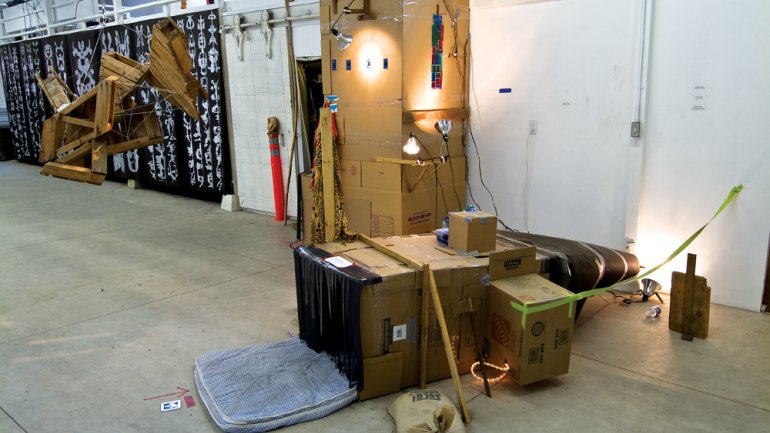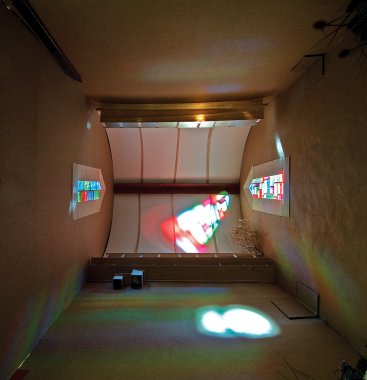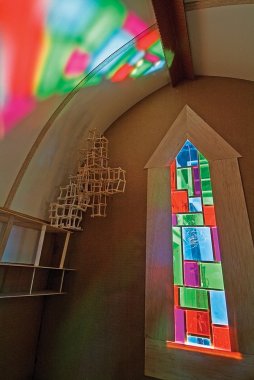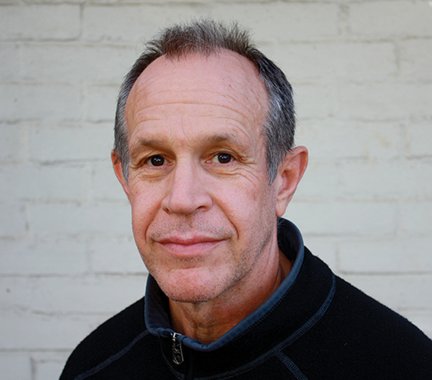Possibilities Cloaked in Hopelessness
Possibilities Cloaked in Hopelessness
I didn’t set out to make work about homelessness in early 2010. But that changed when I encountered a homeless guy holding forth outside a warehouse in Los Angeles, where I was planning site-specific work for a pop-up group exhibition.
The shirtless, shaggy man was sharing his wild drawings with passersby; he started fires on the sidewalk to cook his meals. It was his carnivalesque survival strategies that inspired me to make the Homeless Pavilions – two large cardboard boxes with contemplative interiors such as a Zen garden – which pay homage to the idea that imagination and artistry, or maybe just a sense of home, can be found even in desperate circumstances.
As I created the pavilions, I grew excited about upending the expectations of what people might find when they crawl inside a box. I was reminded of the profound thrill of building forts out of snow or branches and blankets as a child. Where have you ever felt more yourself than in those intimate homemade spaces?
The pavilions’ impermanence added to their poignancy. I found myself tapping into the trend toward downsizing and small, provisional-feeling spaces, as reflected in the current popularity of micro houses and tiny lofts, as well as the rise of migratory lifestyles that online work makes possible. Though some people may still aspire to the McMansion, many others find it a wasteful display of opulence.
After the group exhibition in LA, the boxes were given a second life at 643 Project Space in Ventura – a town two hours away that’s “home” to a large homeless population. I joined forces with artist Chad Sorg, who created the social experiment Artist Fishbowler – a daring high-tech performance of voluntary homelessness, if there can be such a thing. With no safety net, bank account, or apartment, Chad video-streamed his itinerant life – with its strange mix of solitude and lack of privacy – and bartered with other artists, sharing their work on his website in return for food or beer.
I built a box for Chad to live in, also open for viewing, and another pavilion, for a total of four boxes. I gave Chad a small “residency” stipend and pizza dinner as payment for giving tours of the pavilions during the monthlong exhibition.
The opening was spectacular. People arrived on art bikes and formed lines in front of each pavilion, clustering to talk philosophy, homelessness, and art. The most memorable visitor, Chad recalls, was a man who used to be homeless. “He discussed a lot of tricks with me that homeless people engage in – such as climbing into dumpsters – the most amazing of which was what they could do with found items, even food that was found,” he says. Industriousness, the man argued, is at the core of homelessness.
That’s not the way most of us think about it, of course; the image of homeless people is one of shame and tragedy. And at the artists’ talk on the last day of the show, it became clear that homelessness-as-horrific problem took precedence over art that suggested redemption, humor, and choice. People who had initially shown almost childlike glee entering the pavilions had come to censor those reactions. Those invested only in homelessness as a social ill hadn’t even crawled inside. To them, the title Homeless Pavilions probably seemed like an insensitive joke.
And I get it – it’s disturbing to rub up against desperate, bottomless need. It’s disturbing to be reminded of mental illness. It’s disturbing to see how far someone can slide without intervention. It’s disturbing that this level of poverty is even possible in affluent civil society.
We live in a country that doesn’t offer much in the way of a safety net (eroding ever more as I write this) beyond what each person can stitch together for themselves. Many of my artist friends are living fearfully in our stratified economy, one paycheck or one minor health problem away from disaster. This is not foreign territory. That’s what’s terrifying about homelessness – it could happen to any of us.
Still, the pavilions led me to ask what if you found within the lives of the homeless and the interiors of these temporary shelters not degradation but rather a sense of transcendence? What if there were an unexpected light to be found whenever we allowed ourselves to look in the dark places? Isn’t there almost always some attempt to make a place home – to somehow make it feel comfortable and secure, maybe even beautiful or unusual? Don’t people without homes or jobs have moments of fun and creativity? Don’t they experience beauty? And isn’t the DIY “industriousness” my friend Chad described a form of integrity?
Chad’s social project also got me wondering: Maybe there are people who have intentionally dropped out of capitalist society, without a safety net, as a radical act of protest and freedom. Maybe some homelessness is not simply the result of hard luck, addiction, or mental illness. Perhaps there is a modern-day Thoreau or Gandhi, a Western shaman, or even just a principled anarchist under a bridge somewhere.
I imagine someone like that would be a little scary to meet, a destabilizing presence comfortable in places I am not. I’m reminded of the Don Juan Matus character in Carlos Castaneda’s books and of Zen teacher Bernie Glassman’s brave work in the 1990s living among homeless people in Yonkers, New York.
The Homeless Pavilions became wish-fulfilling environments for me, a place to consider possibilities cloaked in hopelessness, where the grass is actually greener inside the box. I loved those boxes.
And then I threw them away.





